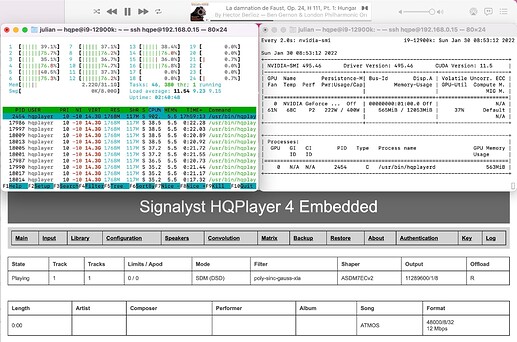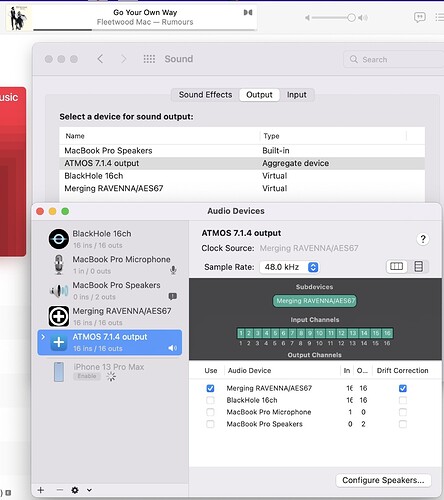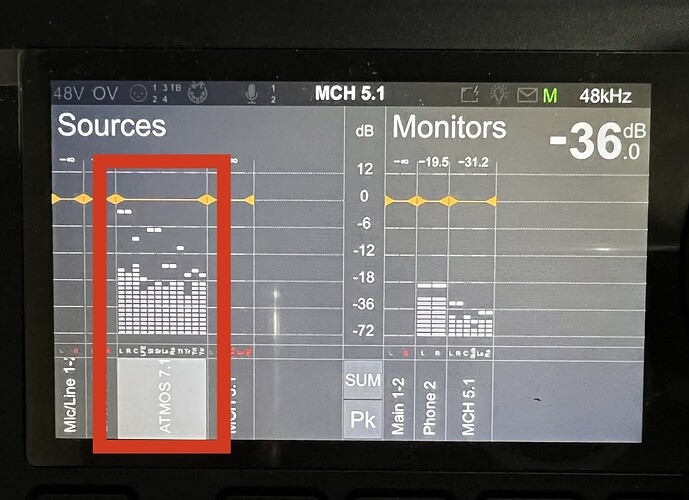macOS’s core audio will decode ATMOS 7.1.4 in system level for you and allows you to send it to multichannel capable DAC.
In my case I use Merging+Anubis to listen to Apple ATMOS music and also watching ATMOS movies in TV app. You can also companion with HQPlayer to do upsampling to multichannel DSD256 then playback.
If your computer is powerful enough you can try 12ch DSD256 upsampling and playback thru Merging+Hapi with 2x DA8P.
Screenshot was ATMOS 5.1.2 upsampling to 8ch DSD256, then playback thru Merging+Anubis Premium.
You are not playing back Atmos that way, just the core/bed channels. An AVR is needed to playback Atmos.
Based on Dolby’s development docs the max ATMOS bed is 7.1.2. In macOS the ATMOS channel is 7.1.4. Apparently it’s not only playback bed channels.
macOS is using Dolby Digital Plus JOC since 2019 which is primary delivery format of Dolby ATMOS. It has spatial elements and core audio will render it.
Don’t forget Logic Pro. It’s the one of the most important DAW software from Apple. Logic Pro is natively support ATMOS authoring. And the ATMOS authoring capability is built upon core audio. So playback ATMOS by this way I don’t see any problem. Get a Logic Pro, a Merging+ audio interface and practice some ATMOS project. You’ll change your perspective.
Apple started supporting direct playback of Atmos on some macs in 2019. I assume it is similar to how phones have supported Atmos but I’m not sure and, honestly, Atmos on 2 speakers (never mind the speakers on small mobile devices) is of little interest to me anyway. To date, AVRs are the only devices I’ve seen handle Atmos on greater than 2 speakers and they usually require the track as is/undecoded (some can handle MAT 2.0 but a lot of devices can’t). If a device that doesn’t support Atmos receives it it just drops the Atmos and plays back the “core” 5.1/7.1 soundtrack (assuming the device supports EAC3/TrueHD).
Like I said, if you have audio interface like Merging+Hapi with 2x DA8P you can have 16 physical analog output channels to handle ATMOS 7.1.4.
In macOS it will decode ATMOS and send it to audio interface.
(In this screenshot my monitor setup was intended downmixing from 7.1.4 to 5.1 in Anubis, not macOS.)
Which piece of software is handling the Atmos objects then?
All core audio tasks.
Can’t agree more. The three albums you reference (Kick, Automatic FTP and Abbey Road) have a killer Atmos mixes and have completely transformed my experience of listening to them.
Yeah, recently played some newer Atmos mixes that are clearly not just quick hack jobs to enter the fray. Fleetwood Mac’s Rumours as an example was pretty carefully (and well) done.
It will happen slowly, but I think surround sound will be increasingly part of the music creation process, not simply remixes of two channel stuff. There’s a bit of it now, it’s a new tool for artists to embrace.
There are only a few out now, but surround can transform live music recordings by putting you more accurately and immersively into the acoustic space of the performance venue, effectively reducing the impact of your venue (aka your room) on the sound.
Sonictransporter will output Roon via HDMI.
Don’t know what’s stopping Roon for not playing Dolby Atmos files.
@ComputerAudiophile has a project ongoing over at Audiofilstyle that will explain all this in detail.
People should have a look there what is possible.
I think he will be able to play Dolby TrueHD in up to 16 channels using Roon.
It’s an ongoing project, so not everything is revealed yet.
No. Roon can’t play Dolby TrueHD or anything more than 8 channels.
I should also add that @Chunhao_Lee and I worked on this together and can decode and successfully play Dolby Atmos TrueHD with all the height channels on Mac and Windows.
Right now is too early to release all the details though.
Can you let us know if you have since become convinced? Follow on…please let us know if the team has any Atmos plans in the offing. Thanks.
Hi @joel i hope you doing well.
are there any talks in roon internally about the Atmos ?
Thanks Again
Can someone help me test Atmos on iOS (Tidal)?
The only way so far that I am aware of to get an Atmos experience through Roon is still limited to 5.1.2 (eight channels) and it requires playing out the TrueHD track (with .thd extension manually replaced with .mlp) through the Dolby Reference Player on a Mac and then recorded by Audacity as an 8-channel FLAC file. In essence, you are “freezing” the Atmos objects to a 5.1.2 format and capturing them in a Roon playable FLAC track. A bit of work, but if you’ve been into standard 5.1 MCH in Roon, you’re already used to a lot of work with ripping and and converting the SACD ISO to DSF tracks.
For Apple Spacial streaming (5.1.2 Atmos), I do bypass Roon and run the Apple Music output from a Mac through HQPlayer for convolution and upscaling to DSD128. Volume control is through HQPDcontrol and the Apple Remote app allows play control of tracks, albums and playlists — but only if you first save them to your library in Apple Music. JCR
PS read a new article here:
If you’re not using an Atmos decoder / renderer it isn’t Atmos. Atmos isn’t just the PCM channels and that is not how it is mixed. Yes, there are distinct PCM channels for an Atmos Master but there is also a set of metadata files which is required to put the mix back together properly (unless you export as binaural which is its own thing).
Unlike “normal” multichannel, Atmos isn’t mixed to individual channels in the DAW. An engineer mixes to 3D space and the Atmos software does the work of both down mixing to your desired format + creating the associated metadata required to recreate the 3D mix. There are multiple ways to encode / export an Atmos Master but all the standard ones include Joint Object Coding to reduce the size / number of objects that need to be tracked / encoded in 3D space. The JOC encoder then uses this information to correctly recreate the 3D space based upon your specific speaker configuration. This is why it needs to be done at the processor, it needs the actual room / speaker set-up.
In the case of Apple Music the export is EC-3 which is Dolby Digital Plus and the Joint Object Coding (DD+JOC) metadata. So, yes, it’s plenty possible to pull the DD+ out of the “mix” but without the JOC it isn’t Atmos as the individual channels are not being encoded into the 3D space that the engineer intended.
I’m sure it sounds very good. It’s just not Atmos, it’s Dolby Digital Plus or TrueHD ![]()
EDIT: Using The Dolby Atmos Reference Player it will decode the additional spatial information within the TrueHD files as pointed out as this thread continues below. I had missed the mention / use of this software from the article when I wrote the above.
Let’s get geeky…
https://learning.dolby.com/hc/en-us/articles/4408217194772-Appendix-C-Dolby-Atmos-Delivery-Codecs-
He is using the Dolby decoder to create the files. It’s Atmos. Wether he captures the 5.1.2 or his system plays the 5.1.2, it’s the same. All goes through the decoder.
If people are wondering how to decode TrueHD with Atmos on a Mac or Windows PC, I wrote about previously.


